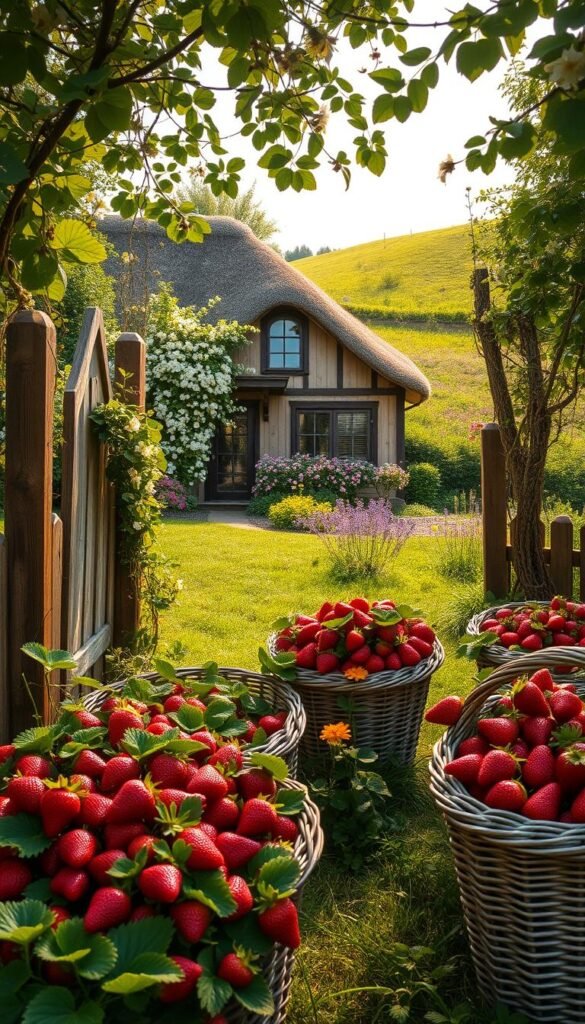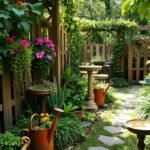Imagine stepping into a space where practicality meets whimsy. Fragaria x ananassa, the common strawberry plant, offers more than juicy snacks—it’s a design powerhouse. These perennials form lush green carpets while producing vibrant fruits, blending edible benefits with visual delight. Best of all, they require minimal effort to thrive year after year.
Their natural spreading habit creates instant ground cover, reducing soil erosion while adding texture. You’ll find these plants work double duty: feeding your family and framing your outdoor areas with rustic appeal. Pair them with climbing vines or stone pathways for a look straight from a storybook.
Planning matters. In their first season, plants focus on root development, so patience pays off. By year two, runners expand your green canvas naturally. This growth pattern lets you craft expansive layouts without constant replanting. For inspiration, explore how the cottagecore aesthetic uses similar organic elements.
Balance beauty with function. Choose sunny spots and well-draining soil to maximize yields. Interplant with herbs like thyme to repel pests naturally. As seasons change, watch your space transform—from spring blossoms to summer’s ruby gems against emerald leaves. It’s a living artwork that grows richer with time.
Embracing the Strawberry Garden Aesthetic: Sweet Berries and Cottage-Style Charm
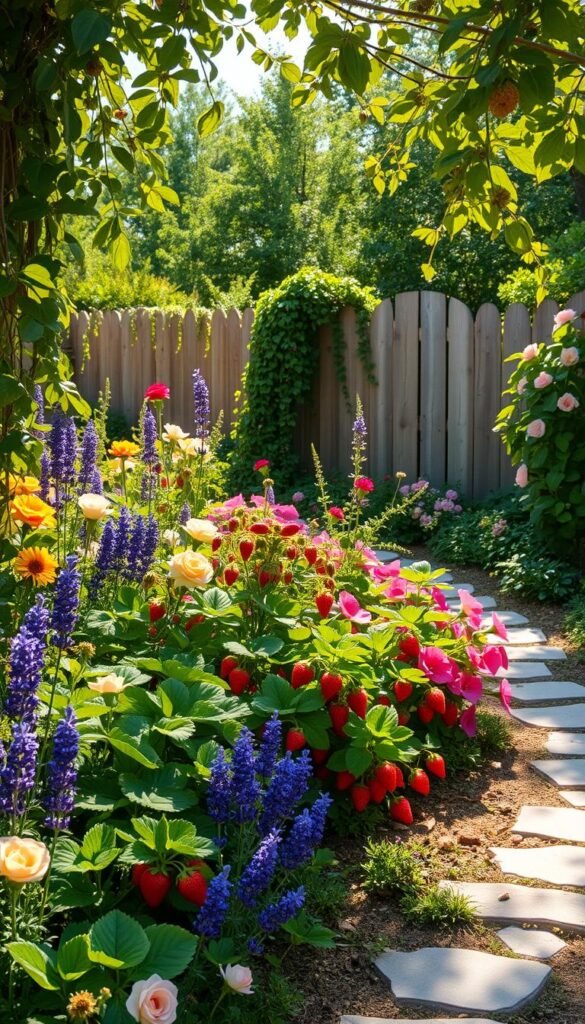
Picture a landscape where snacks grow beside flowers. This edible paradise merges delicious fruit with old-world character. By blending productive plants with classic cottage garden elements, you craft spaces that nourish both body and soul.
Discover the Unique Blend of Edible Beauty and Cottage Charm
Traditional cottage gardens thrive on layered texture and purpose. Pair ruby-hued berries with lavender’s purple spikes or thyme’s creeping greenery. These companions create visual harmony while repelling pests naturally—a perfect marriage of design and function.
Climbing roses add vertical drama near strawberry patches. Their soft petals mirror the color of ripe fruit, creating cohesive beauty. For continuity through seasons, mix June-bearing and everbearing varieties. Early blooms sync with peonies, while late harvests align with chrysanthemums.
Setting Your Vision for a Perfect Garden
Start by sketching zones for relaxation and growth. Allow strawberry runners to spill slightly over pathways for that “lived-in” charm. Use raised beds edged with reclaimed bricks to define spaces without rigid formality.
Incorporate seating areas surrounded by fragrant herbs. Mint’s fresh scent enhances summer evenings, while rosemary adds structure year-round. For more ideas on elevating your space, consider how stone borders or vintage tools can amplify rustic appeal.
Remember: the magic lies in balanced imperfection. Let some plants self-seed between berries, welcoming surprises like poppies or daisies. Your edible landscape becomes a living scrapbook of flavors and memories.
Understanding Strawberry Growth and Essential Care
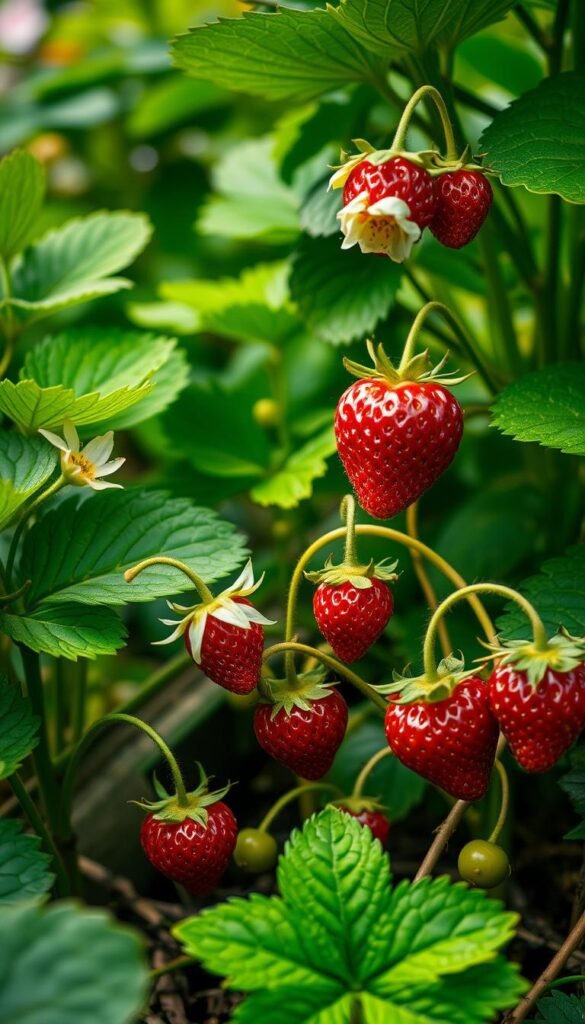
Your journey to a thriving edible landscape starts with smart plant choices. Whether you’re aiming for visual impact or bountiful harvests, matching varieties to your environment ensures success. Let’s explore how to set up a maintenance rhythm that keeps your space productive and picturesque.
Selecting the Right Strawberry Varieties for Your Climate
Everbearing types like ‘Seascape’ deliver flowers and berries from spring through fall, perfect for continuous color. These work wonders in containers or mixed borders. Day-neutral varieties adapt to shifting sunlight, letting you produce fruit even in partly shaded spots.
Full sun remains non-negotiable—six daily hours minimum. When starting from seeds, consider your region’s frost dates. Northern gardeners often prefer June-bearing types for their cold tolerance, while Southern growers lean on heat-resistant everbearers.
Establishing a Routine for Plant Health
Consistent moisture fuels root development and plump berries. Water deeply 2-3 times weekly, adjusting for rainfall. Pair this with balanced fertilization—feed early in the growing season, then again after first harvest.
Watch for pale leaves or stunted growth—they signal nutrient needs. Trim runners in late summer to focus energy on fruit production. Come winter, mulch protects crowns from freezing temps. For detailed care strategies, our beginner-friendly checklist simplifies seasonal tasks.
Remember: healthy plants mean fewer pests. Rotate crops every 3-4 years to prevent soil-borne diseases. With thoughtful planning, your patch becomes a self-sustaining showcase of flavor and form.
Designing Your Cottage-Style Strawberry Garden
Transform your outdoor space into a living canvas where flavor meets flair. By blending edible crops with ornamental flowers, you craft a garden design that delights the senses while serving practical needs. Let’s explore how to merge productivity with timeless charm.
Integrating Edible Elements with Traditional Cottage Flowers
Pair ruby-fruited strawberry plants with sunflowers’ golden faces or hollyhocks’ towering spires. These combinations create dynamic color texture while attracting pollinators. For subtle contrasts, nestle white-blossomed varieties between pastel hydrangeas or lavender bushes.
Raised beds offer perfect staging grounds. Grow thyme along the edges to suppress weeds, letting strawberry runners cascade over wooden sides. This layered look maximizes space while keeping herbs within easy reach for kitchen use.
Planning Layouts That Maximize Curb Appeal
Curved pathways lined with peonies guide the eye toward berry patches. Position everbearing varieties near seating areas where their June-to-frost fruits become edible decor. For vertical interest, train clematis vines up trellises behind strawberry containers.
Front-yard designs shine when you cluster colorful combos near property lines. Try red berries against blue salvia or yellow coreopsis for high-impact displays. Need more inspiration? Our guide to creative gardening ideas offers fresh approaches to layout planning.
Remember: successful cottage garden designs balance spontaneity with intention. Let some plants self-seed between orderly rows, creating that cherished “lived-in” appeal visitors adore.
Vertical Strawberry Planters: Maximizing Small Spaces
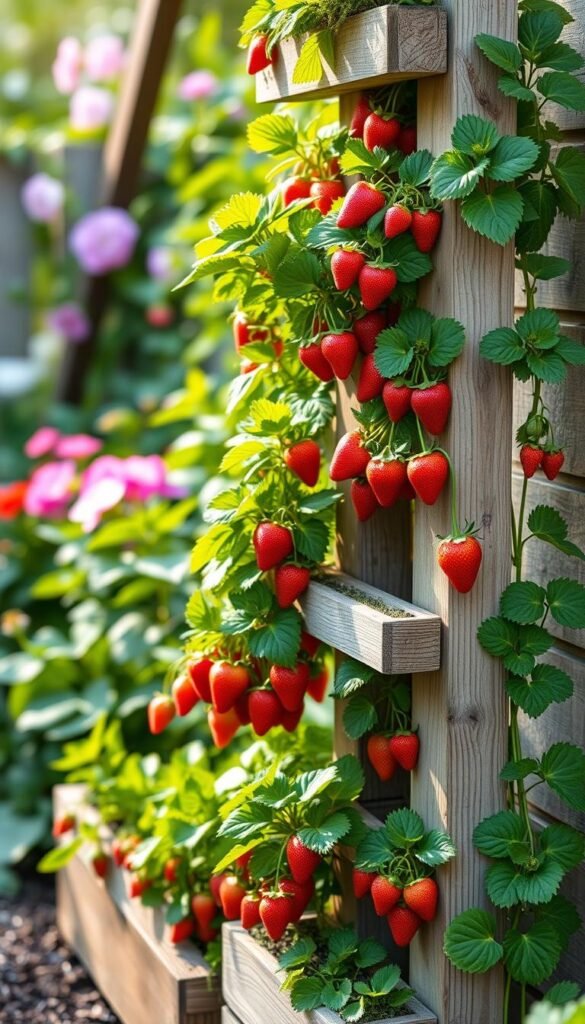
Small spaces hold big potential when you grow upwards. Vertical systems let you turn walls, balconies, and patios into lush edible displays. This approach isn’t just space-smart—it creates eye-catching focal points while boosting harvests.
Choosing the Perfect Containers and Structures
Look for planters with side pockets or stacked tiers. These designs let you grow 6-8 plants per square foot—triple traditional methods. Pop-up trugs on legs offer modern flair and waist-high access, while galvanized steel towers suit industrial-chic spaces.
Hanging baskets need depth for roots. Aim for 16-inch diameters with coconut liners to retain moisture. Wooden pallet planters work well for rustic themes, but line them with landscape fabric to prevent soil loss.
Implementing Vertical Gardening Techniques
Position structures where berries get morning sun and afternoon shade. This reduces water stress while ensuring sweet fruit development. Stagger planting dates in multi-level systems for continuous harvests from spring through fall.
Use drip irrigation or self-watering pots to maintain consistent moisture. One gardener reported, “My vertical setup yields 30% more fruit since improving airflow reduced mold issues.” Secure heavy planters to walls or railings to handle weight when fully loaded.
Pair trailing varieties like ‘Tristan’ with compact types such as ‘Albion’ for texture contrast. Rotate planters quarterly to ensure even light exposure. With smart planning, your vertical gardening project becomes both practical and picturesque.
Enhancing Garden Beauty with Ground Cover and Mosaic Patterns
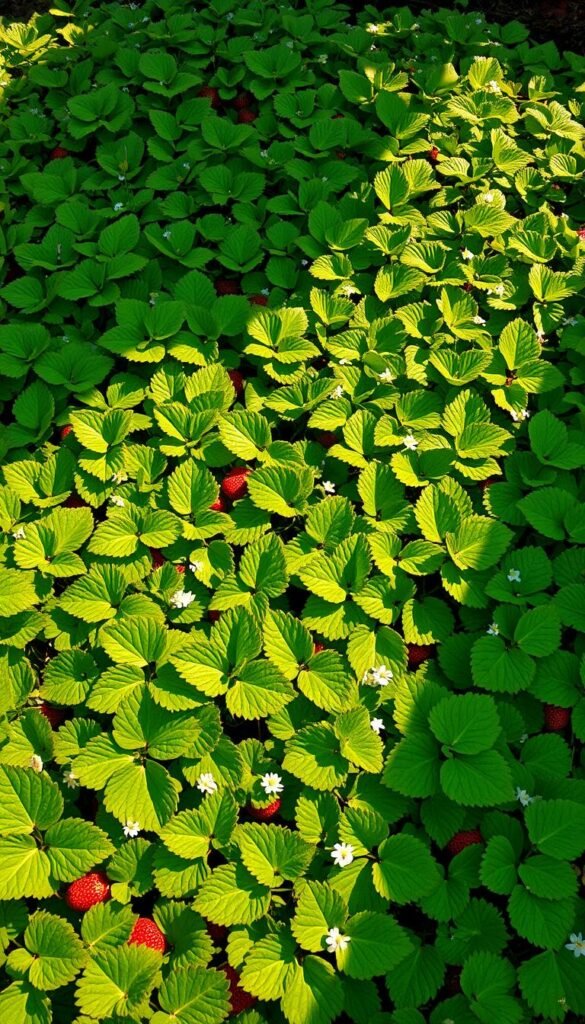
Turn overlooked spaces into edible tapestries using nature’s living brushstrokes. Strategic planting transforms slopes, walkways, and bare patches into functional art that feeds both eyes and appetite.
Creating a Lush Green Carpet With Ground Cover
‘Seascape’ strawberries excel as living mulch, spreading vigorously to form emerald mats. Space them 12-18 inches apart initially—they’ll fill gaps within months. Their trailing habit softens hard edges along paths while suppressing weeds naturally.
Slopes become erosion-resistant masterpieces when carpeted with these plants. You’ll harvest ruby fruits while enjoying improved soil stability. One gardener noted, “My hillside stopped washing away and started producing dessert!”
Incorporating Mosaic Designs for Visual Impact
Mix varieties like ‘Mara des Bois’ (conical fruits) with ‘Pineberry’ (white berry hues) for contrast. Alternate leaf shapes and fruit colors in geometric waves or spirals. This approach adds touch of artistry while maximizing yield.
| Variety | Leaf Texture | Fruit Color | Pattern Role |
|---|---|---|---|
| Seascape | Glossy | Deep Red | Background Fill |
| Albion | Rugged | Bright Scarlet | Bold Accents |
| Pink Panda | Serrated | Rosy Blush | Delicate Edging |
Maintain designs by redirecting runners into pattern gaps. Pair with creeping thyme for silver-green texture contrasts. Your garden becomes a dynamic canvas—spring’s white blooms shift to summer’s jewel-toned harvest against ever-changing foliage.
Adding Functional Decor and Architectural Elements
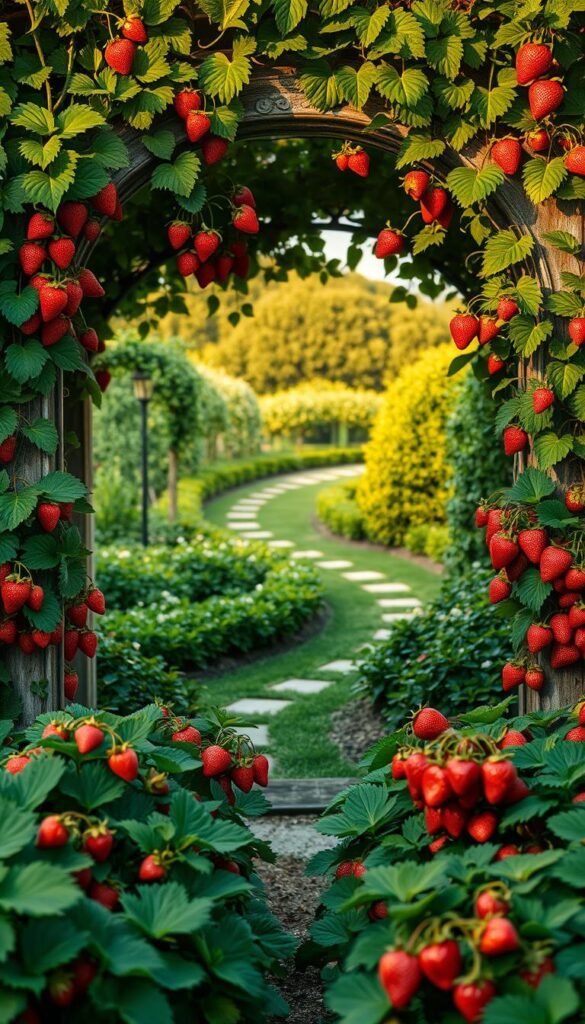
Turn ordinary pathways into enchanting tunnels of greenery and fruit. Sturdy structures like archways do more than support trailing plants—they create immersive experiences. These installations guide movement through your space while doubling as vertical growing zones.
Building Archways and Trellises to Frame Your Space
Choose materials that mirror your home’s style. Weathered wood suits rustic themes, while powder-coated metal offers modern durability. One gardener shared, “My copper trellis develops a patina that complements ripening fruit—it’s art that evolves with the seasons.”
| Material | Best For | Maintenance |
|---|---|---|
| Cedar | Rustic Designs | Annual Sealant |
| Galvanized Steel | Modern Spaces | Wipe Down Seasonally |
| Recycled Plastic | Coastal Areas | Hose Monthly |
Position structures where morning sun bathes the upper sections. This ensures proper fruiting while creating dappled shade below—perfect for benches or decorative statues.
Balancing Aesthetic Elements with Practical Functionality
Secure installations with concrete footings to withstand wind and plant weight. Leave 18-inch access gaps between structures for easy harvesting. For narrow areas, use wall-mounted trellises that save floor space.
Opt for open-weave designs that let runners weave naturally. This reduces pruning needs while creating lush curtains of leaves and berries. Pair with compact varieties like ‘Toscana’ to maintain walkway clearance.
Integrating Fruity Elements and Complementary Edibles
Create a symphony of flavors by blending multiple fruit varieties in your edible oasis. Thoughtful pairings extend harvest windows while enhancing visual depth. Let’s explore how to layer textures and tastes for year-round rewards.
Strategic Plant Partnerships
Early-blooming cherry trees shower petals over emerging strawberry blossoms each spring. Their white flowers mirror the delicate beauty of berry blooms, creating seamless transitions. Come summer, raspberry canes rise behind low-growing plants, offering vertical contrast and juicy rewards.
Blueberry bushes thrive in similar acidic soil conditions. Their fiery fall foliage complements autumn-harvested berries, while dwarf apple trees frame spaces without casting shade. One gardener noted, “My compact Honeycrisp gives just enough apples for pies without blocking sunlight.”
For tight spaces, try columnar fruit trees in containers. These space-savers produce fruit along their trunks, leaving room for sprawling ground covers. Pair them with everbearing varieties that yield delicious fruit from June through frost.
This layered approach transforms your plot into a living pantry. You’ll enjoy blossoms in spring, berries in summer, and crisp apples in fall—all within a cohesive, productive design.

